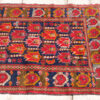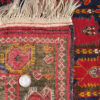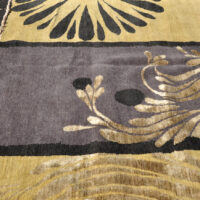Description
Fabulous vintage Turkoman Beshir runner with bold greens, yellows, reds and blues.
Excellent overall condition with very little signs of wear. The rug is out of a German estate.
Exact size is 10 ft. 4 in. by 2 ft. 10 in. Natural wool — including warp and weft structure. Long wool fringes with minor wear.
The side cords are in great condition and appear original. No holes or weak spots, etc.
Beshir rugs are much less common than many of the Ersari Turkoman carpets from Afghanistan.
This Beshir rug is in wonderful condition. 1970s.
Probably woven in the Turkmenistan region.
The Beshir
The Beshir are usually considered a sub-group of the Ersari Turkoman although the ethnography of the Turkoman people is highly nebulous. Most of these large Beshir rugs are woven in and around Bukhara, which is a large city in Uzbekistan. With an age of late 1920s to late 1940s, this is a Soviet era carpet as Uzbekistan was the Uzbek Soviet Socialist Republic from 1924 until 1991 with the breakup of the Soviet Union.
Unlike other Turkoman tribes, the Beshir have created a highly distinctive weaving style. Featuring bright colors and fewer simple geometric designs, the Beshir tribe features intricate motifs and stylized floral patterns. Because of their distinct style and vivid colors, Beshir rugs are heavily sought after by collectors.
The Beshir tribe inhabit parts of Uzbekistan, especially around Bukhara, the Amu Darya Valley in Turkmenistan, and small areas in Afghanistan. While some Turkoman tribes entered these regions as early as the 11th century A.D., some ethnographers believe that the Beshir were a much later group that settled in the region in the 17th century after being forced out of their homeland in the Balkans by political turmoil.
Because their origin is distinct from other peoples in Uzbekistan and Turkmenistan, the rugs the Beshir weave have a unique aesthetic. While there is variation among Beshir rugs, their style is so distinct that attribution is seldom a problem.
Beshir rugs are finely knotted, typically in the range of 60 to 160 knots per square inch. The foundation is usually wool, though some of the Afghan Beshir use a mixture of wool and goat’s hair. In contrast to other Turkoman groups, the Beshir do not use guls (tribal emblems) as the foundation of their designs. Instead, Beshir rugs feature all-over repeating patterns with images taken from nature, such as leaves, vines, stars, and sometimes animals.
Beshir rugs are also distinct in coloring. While Turkoman rugs generally are dominated by deep reds and blues, Beshir rugs often place these shades alongside lighter and brighter colors such as reds and yellows. The result is a vital, exuberant appearance that contrasts to the somber tones of some other Turkoman rugs.
U.S. shipping is $34. Or free pickup in Tucson, Arizona.
Please contact me with questions. Thank you.
(BE0002 G16)












